Chapter 4 -Extensions of Mendelian Inheritance
1/62
Earn XP
Name | Mastery | Learn | Test | Matching | Spaced |
|---|
No study sessions yet.
63 Terms
Mendelian Inheritance
Inheritance patterns that obey two laws: the law of segregation and the law of independent assortment.
Simple Mendelian Inheritance
Inheritance that typically obeys two qualifications: (1) a single gene will have two different alleles (2) alleles display a simple dominant/recessive relationship.
Wild-Type Alleles
Prevalent alleles in a population. They typically encode for proteins that function normally and are made in the proper amounts. More than one of these alleles can be produced in large populations by genetic polymorphism.
Mutant Alleles
Alleles that have been altered by mutation. They are often defective in their ability to express a functional protein and tend to be rare in natural populations. They are usually inherited in a recessive manner.
1) 50% of the normal protein (dominant) is enough to accomplish the proteins cellular function
2) The heterozygote might produce more than 50% of the functional protein because the normal (dominant) gene is up-regulated to compensate for the lack of function of the defective allele
What are two reasons why the recessive allele often doesn’t affect the phenotype of a heterozygote?
Dominant / recessive / 100 / 50 / 0
Fill in the blank….
For purple vs. white pea plant flowers, the ( ) allele produces the purple color while the ( ) allele results in the absence of purple color. As such, for plants with either a PP, Pp, or pp genotype, they have ( )%, ( )%, and ( )% of the functional protein that produces the purple color.

Recessive / homozygous / hemizygous
Fill in the blank…
In many human genetic diseases, the ( ) allele contains the mutation and prevents the allele from producing a fully functional protein. Individuals who exhibit the disease are either ( ) or ( ) for the recessive allele.
Hemizygous
A situation in which an individual needs only one copy of a gene instead of the usual two.
Ex) When a gene is located on a sex chromosome (X)
1) The protein encoded by the mutant gene is changed so it gains a new or abnormal function
2) The protein encoded by the mutant gene acts antagonistically to the normal protein
3) The mutant gene is loss-of-function, meaning it doesn’t make enough product to give the wild type phenotype
What are three reasons why dominant mutations are less common than recessive?
Incomplete Penetrance
When a dominant allele does not always penetrate into the phenotype of the individual.
Ex) Polydactyly causes affected individuals to have additional fingers and/or toes. A single copy of the allele is often sufficient to cause the condition, but some individuals carry the dominant allele but don’t exhibit the trait.
Dominant / penetrant
Fill in the blank…
The measure of penetrance is described at the population level. If a certain percentage of heterozygotes carry a ( ) allele and exhibit the trait, then that trait is ( ) in that same percentage.
Expressivity
The degree to which a trait is expressed.
Ex) Polydactyly - a person with several extra digits has a high value of this while a person with one extra digits has a low value.
Environment
Fill in the blank…
The ( ) has a great impact on the phenotype of an individual.
Ex) Individuals with phenylketonuria (PKU) may remain symptom-free if they are detected early and are fed a diet free of phenylalanine.
Temperature-Sensitive Allele
The expression of an allele or gene varies with a change in environmental temperature.
Ex) Arctic foxes have grayish brown fur in the summer and white in the winter.
Incomplete Dominance
When the heterozygote exhibits a phenotype that is intermediate between the corresponding homozygotes.
Red / white / pink / 1:2:1
Fill in the blank…
An example of incomplete dominance is the flower color in the four o’clock pea plant
This plant has two alleles: CR for the wild-type allele for ( ) color and CW for the allele for ( ). During a cross of homozygous white and red flowers, the F1 generation produced all ( ) flowers because having only 50% of the CR protein was not enough to produce the red color. In the F2 generation, there was a ( ) ratio of red : pink : white.
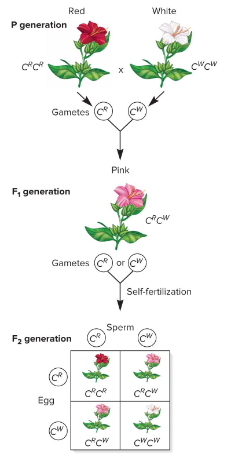
Homozygous recessive / Rr
Fill in the blank…
Whether a trait is dominant or incompletely dominant may depend on how closely the trait is examined.
Ex) Despite what Mendel initially thought (the wrinkled peas must be ( )) the wrinkled pea pod was found to also have the ( ) genotype along with the heterozygous round pods. In fact, upon microscopic examination, the heterozygotes looked round but had half the amount of starch found in the homozygous dominant pods.
As such, the wrinkled peas, despite having the genotype, produced 0% of the functional protein.

Overdominance
The phenomenon in which a heterozygote has greater reproductive success compared to both of the corresponding homozygotes. This can also be called the heterozygote advantage.
Ex) Sickle Cell Disease
Sickle-Cell Disease
An autosomal recessive disorder in which affected individuals produce abnormal forms of hemoglobin.
HbA
The hemoglobin allele that encodes normal hemoglobin, hemoglobin A
HbS
The hemoglobin allele that encodes the abnormal hemoglobin, hemoglobin S.
Homozygous / anemia / circulation
Fill in the blank…
Individuals who are ( ) for the abnormal hemoglobin protein have red blood cells that deform into a sickle shape under conditions of low oxygen tension. This results in…
1) Shortened life span of red blood cells → ( )
2) Clumping of odd-shaped cells → blocking of ( )
HbAHbS / sickle cell / malaria
Fill in the blank…
Those who have the ( ) genotype have an advantage over those with homozygous abnormal genomes because they don’t suffer from ( ) They also have an advantage over those who are homozygous for the normal protein because they are more resistant to ( ).
Malaria
A blood disease caused by the protozoan Plasmodium. The parasite undergoes its life cycle in mosquitos and then in red blood cells. Those who are heterozygous for abnormal hemoglobin can’t really be infected with this because their red blood cells will rupture when infected, preventing propogation of the parasite.

1) Disease resistance
2) Homodimer formation
3) Variation in functional activity
What are three possible explanations for over dominance at the molecular or cellular level?
Homodimers
Proteins that are composed of two subunits, encoded by the same gene, but the alleles of the gene can be different.
Homodimers / heterozygous
Fill in the blank….
A1A2 heterozygotes can produce homozygous and heterozygous ( ), i.e. A1A1, A2A2, and A1A2. Homozygotes (A1A1 and A2A2) can only produce homozygous pairs. For some proteins, the ( ) pairing may have better functional activity and gives the organism superior characteristics.
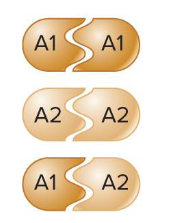
Disease resistance
Fill in the blank…
Over dominance likely occurs because a heterozygote confers ( ), unlike a homozygote.
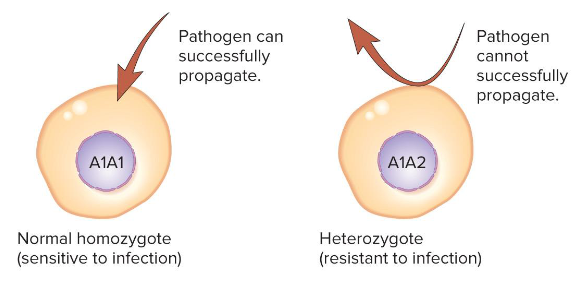
Environmental conditions
Fill in the blank…
Overdominance likely occurs for one reason due to a variation in functional activity. For instance, a gene, E, encodes a metabolic enzyme. The two alleles individually produce enzymes that function at either high or low temps. A heterozygote produces both enzymes, so the advantage of a heterozygote is that its enzymes function over a wider range of ( ).
Multiple Alleles
Commonly found in natural populations and typically occurs in three or more.
Ex) ABO blood group
Antigens
Substances that are recognized by antibodies produced by the immune system. Blood type is determined by which substance is present on the surface of red blood cells.
1) IA produces antigen A
2) IB produces antigen B
3) i does not produce either antigen
What are the three alleles encoding for the antigens present on red blood cells and what antigen do they code for?
O / codominant / AB / recessive
Fill in the blank…
Individuals who are homozygous for i produce blood type ( ). The IA and IB alleles are ( ) and are both expressed in a heterozygous individual, producing blood type ( ). Since i is ( ) to IA and IB, those with blood type A or B can be heterozygous or homozygous for IA or IB.

Glycosyl transferase / defective / N-acetylgalactosamine / galactose
Fill in the blank….
The carbohydrate tree on the surface of red blood cells is composed of three sugars. A fourth can be added by the enzyme ( ). The i allele encodes a ( ) enzyme, so the tree remains unchanged. The A allele encodes a form of the enzyme that adds ( ) while the B allele encodes a form of the enzyme that adds ( ) to the tree.
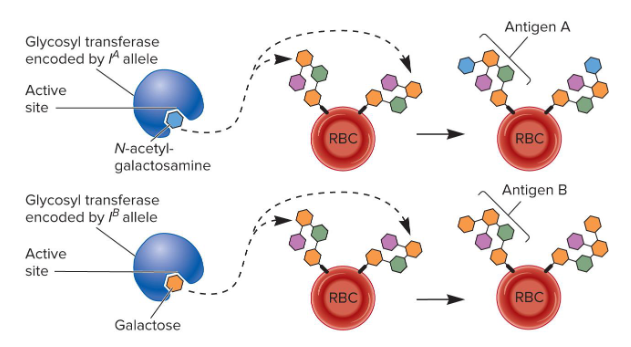
If they aren’t a good match, the antibodies in the recipient’s blood will react with antigens in the donated blood cells, causing donated blood to agglutinate and clog blood cells.
The A and B antigens are different enough to be recognized by different antibodies. Why does a donor’s blood have to be an appropriate match with the recipient’s blood?
1) Have no affected offspring, but females are carriers
2) All males are affected but all females are carriers
Males can transmit either an X or Y chromosome while females can only transmit one X chromosome. What are some general trends on a pedigree for X-linked traits for these two conditions?
1) An affected male and unaffected female
2) An affected female and unaffected male
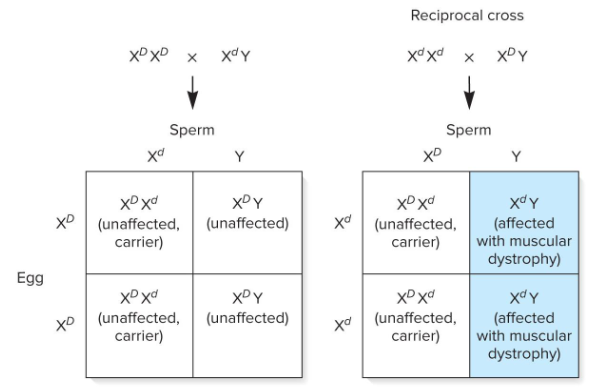
Holandric Genes
Also called Y-linked genes, these are transmitted only from father to son and are quite rare.
X-Linked Genes
Genes that are hemizygous in males. Males only need one copy of this gene to be affected. Males are more likely to be affected
Pseudoautosomal Inheritance
Refers to the very few genes found on both X and Y chromosomes. They are found in homologous regions needed for chromosome pairing.
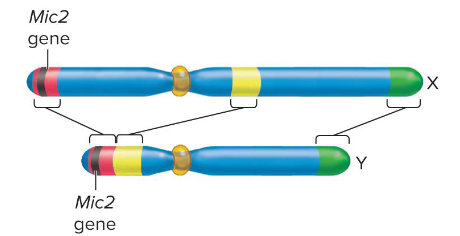
Sex-Influenced Inheritance
Traits where an allele is dominant in one sex but recessive in the opposite sex. It is a phenomenon in heterozygotes. These traits are autosomal, meaning they are not sex-linked.
Ex) Scurs, a horn-like growth on the frontal bone in cattle, is caused by an autosomal gene. The Sc allele is dominant in males but recessive in females.
Sex-Limited Inheritance
Traits that occurs in only one of the two sexes. These genes are controlled by sex hormones or the sexual development pathway.
Ex) Ovary development is limited to females while testes growth is limited to males.
Lethal Allele
An allele that has the potential to cause the death of an organism. They are typically the result of mutations in essential genes and are usually inherited in a recessive manner. The absence of the protein produced by essential genes leads to a lethal phenotype.
Dominant / homozygotes
Fill in the blank…
A lethal allele may produce ratios that deviate from Mendelian ratios.
Ex) The Manx cat carries a ( ) mutation that affects the spine and shortens the tail. It is lethal for ( ).
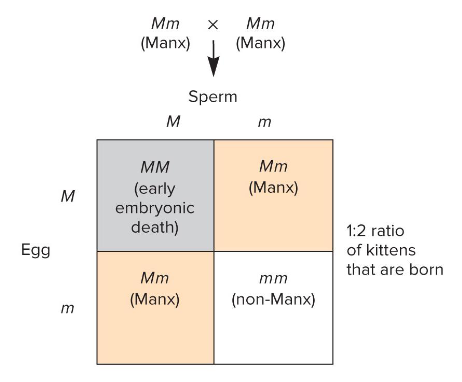
Time
The ( ) in which a lethal effect is exerted can vary. They can often prevent cell division, killing an organism at an early age. They may exert their effect later in life, such as in Huntington’s disease.
Conditional Lethal Alleles
Lethal alleles that may kill an organism only when certain environmental conditions prevail.
Ex) A developing fruit fly will die at 30 C but survive if grown at 22 C. This is caused by mutations that alter the structure of the protein at the non-permissive temp (30 C)
Semilethal Alleles
A kind of lethal alleles that kills some individuals in a population, but not all of them. Environmental factors and other genes may help prevent the detrimental effect of these genes.
Pleiotropy
When a single gene has multiple effects on the phenotype of an organism. This can occur when the gene product affects cell function in more than one way. It may also be expressed in different cell types and at different stages of development.
Ex) A defect in the CFTR protein (causes cystic fibrosis) can have multiple effects: thick mucus in lungs, salty sweat on skin, and poor weight gain due to blockages in tubes that carry digestive enzymes (caused by the inability to properly transport Cl and regulate ion balance)
Melanocytes
Cells that produce the pigment melanin, which is typically found in the skin, eyes, and hair.
Multiple alleles / decrease / migration
Fill in the blank…
The spotting gene (S) exists in ( ) that affect the amount of pigmentation of an animal’s fur. During embryonic development of dogs, melanocyte precursor cells migrate away from the trunk region of the neural case. The white-spotting phenotype in these dogs is likely caused from alleles that produce a ( ) in the number of melanocytes due to failure in melanoblast ( ), proliferation, and/or survival.
Gene Interactions
These occur when two or more different genes influence the outcome of a single trait. Essentially all traits are affected by contributions of many genes.
Ex) Height and weight are affected by many different genes in combination with environmental factors.
Epistasis
When a gene can mask the phenotypic effects of another gene. Alleles of one gene mask the phenotypic effects of the alleles of a different gene. This often arises because two or more different proteins participate in a common cellular function.
Ex) Colorless precursor (1) → Colorless intermediate (2) → Purple pigment
(1) Enzyme C (2) Enzyme P
Homozygosity of either P or C results in the flowers having white pigment (even if one is heterozygous or homozygous dominant). Thus, the cc gene masks the Pp or PP gene.
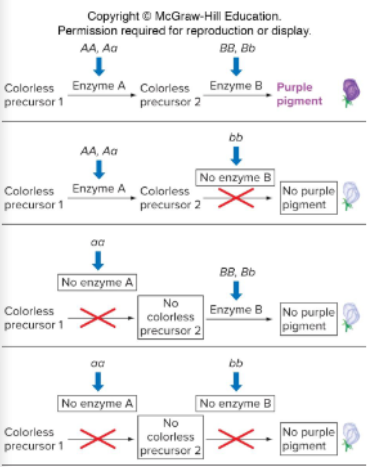
Complementation
A phenomenon in which two parents that express the same or similar recessive phenotypes produce offspring with a wild-type phenotype. This occurs because each recessive allele is complemented by a wild-type allele
Ex) In the flowers’ P generation, both white flowers were homozygous recessive for either the p or c gene (CCpp or ccPP). Since at least one of the genes was homozygous recessive, the gene masked the purple pigment and kept the flower white (epistasis). In the F1 generation, all the flowers were purple because each recessive allele ended up being accompanied by a wild type allele (C or P). No genes could be masked since all genes involved were heterozygous dominant.
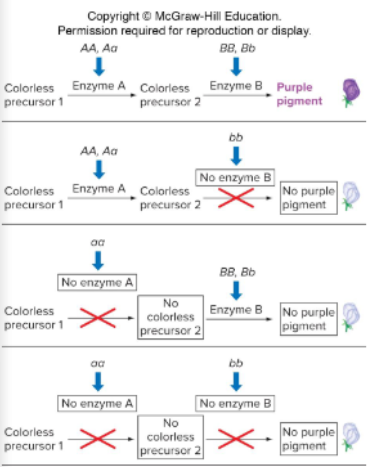
Purple / white / purple / white
Fill in the blank…
In Bateson and Punnett’s experiment, they found that flower color was determined by two different genes. In one, the C or ( )-producing allele is dominant to c ( ). In another, the P or ( )-producing allele is dominant to p ( ). cc or pp masks the P or C alleles and produces a white color even if the other gene is not homozygous recessive.
Eumelanin / Homozygous recessive / epistatic /
Fill in the blank…
Epistasis in Labrador retrievers
Gene B alleles determine black and brown because they deposit ( ). The ( ) genotype ee or gene E is ( ) to B and determines yellow since it does not synthesize this protein (it masks the Bb or BB or BB genotypes).

H_ / hh (homozygous recessive)
Fill in the blank…
Recessive epistasis in humans with a rare blood type
The gene for substance H is epistatic to the ABO gene. Without this substance, the A and B sugars can’t attach to red blood cells. All type A, AB, B, and type O people are ( ), while people with the ( ) genotype will appear to be type O since the A and B sugars have nothing to attach to even if they are present.
This causes someone who carrier the A and B alleles to appear to be type O.
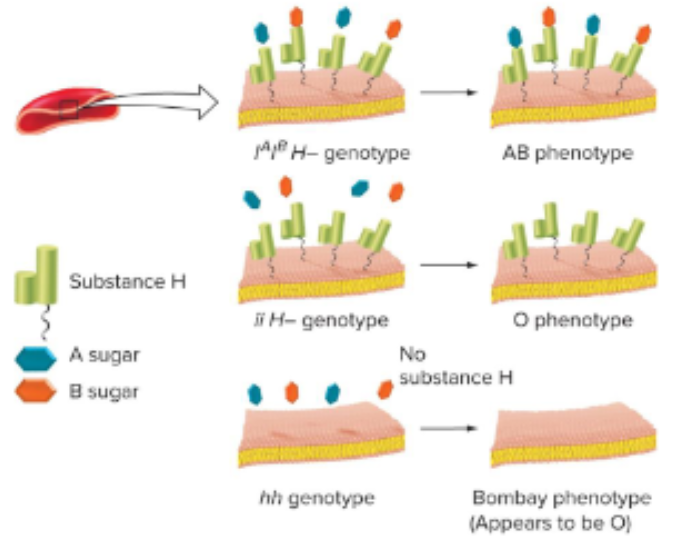
Dominant / deposition
Fill in the blank…
Dominant epistasis in summer squash
Since a majority of progeny were A_ and B_, it can be stated that the ( ) allele of one gene masks both alleles of another gene. This is because protein B is a dominant allele that prevent pigment ( ) and is epistatic to any A allele, leaving squash white even when it starts as green.
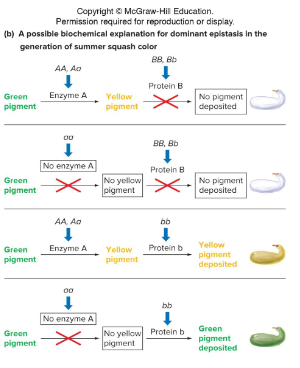
Agouti / colored / aa / cc
Fill in the blank…
Inheritance of coat color in rodents is regulated by two genes: A for ( ) and C for ( ). The first regulates the shift from black at the tips to brown near the root (synthesizes the yellow pigment near the roots that mixes with black to make brown). The second allows for any pigmentation to occur. ( ) results in black hair while ( ) results in albino fur.
C / aa / albino / epistatic
Fill in the blank…
Example of gene modifier effect
At least one copy of each dominant allele results in agouti color. An animal with one dominant ( ) but recessive ( ) will be black. The cc animals are ( ), even if the dominant A is present. As such, c is ( ) to A.
Gene Knockout
Techniques in which geneticists can directly generate loss-of-function alleles. Many have no obvious effect on phenotype.
Paralogs
Two or more copies of similar genes that may not be identical due to the accumulation of random changes during evolution.
Redundancy / paralogs
Fill in the blank…
Gene knockout may not occur due to gene ( ). As such, an organism may have ( ) of a gene. As such, if one gene is missing, the other copy may be able to carry out the missing function.
Increased
Fill in the blank…
Gene knockout might not work because if a protein involved in common cellular function is missing, the function of another protein may be ( ) to compensate for the missing protein and overcome the defect.
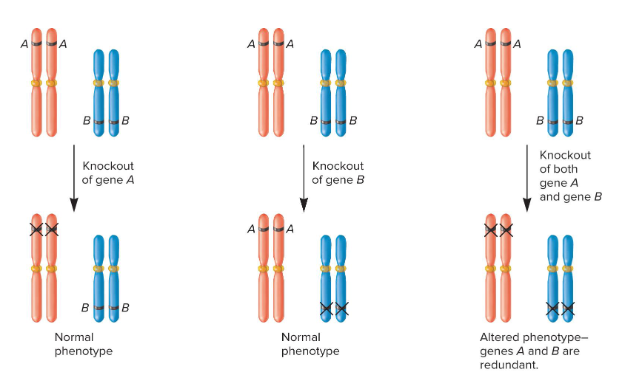
Gene Redundancy
When two or more genes perform the same function in an organism.
Ex) Triangular capsule crossed with ovate capsule plant. F1 was all triangular while F2 had 15 triangular and 1 ovate plant. As such, at least one copy of T or V needed to be there to produce a triangular plant. Only when a plant was recessive for both genes was it ovate (eliminating the redundant alleles caused a change in phenotype).